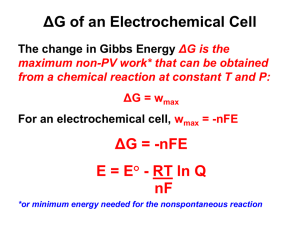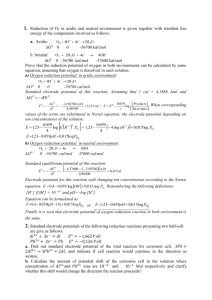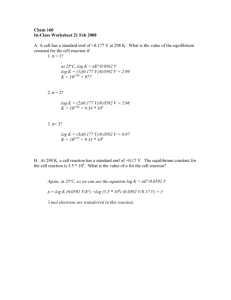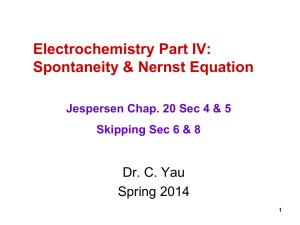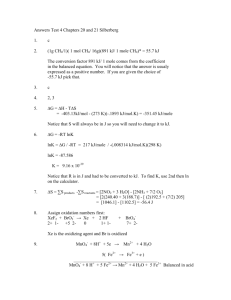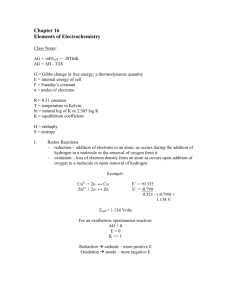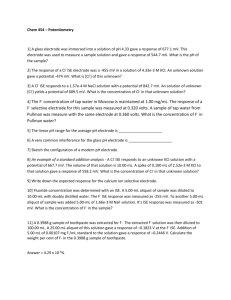Nernst Equation: Eh, pe, and Water Stability
advertisement
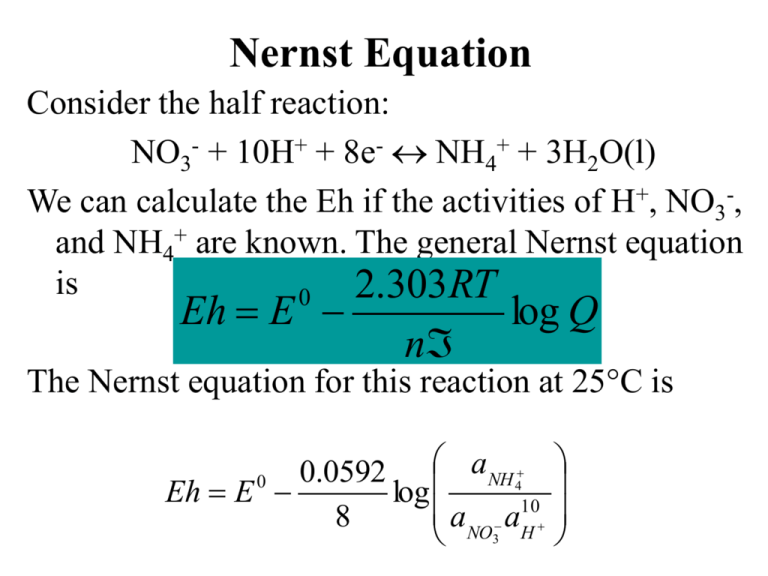
Nernst Equation Consider the half reaction: NO3- + 10H+ + 8e- NH4+ + 3H2O(l) We can calculate the Eh if the activities of H+, NO3-, and NH4+ are known. The general Nernst equation is 2.303RT 0 Eh E n log Q The Nernst equation for this reaction at 25°C is aNH 0 . 0592 4 Eh E 0 log aNO a10 8 3 H Let’s assume that the concentrations of NO3- and NH4+ have been measured to be 10-5 M and 310-7 M, respectively, and pH = 5. What are the Eh and pe of this water? First, we must make use of the relationship G E n 0 o r For the reaction of interest rG° = 3(-237.1) + (-79.4) - (-110.8) = -679.9 kJ mol-1 679.9 E 0.88 volts (8)( 96.42) 0 The Nernst equation now becomes 0.0592 aNH 4 Eh 0.88 log 10 8 aNO aH 3 substituting the known concentrations (neglecting activity coefficients) 0.0592 3 107 Eh 0.88 log 0 . 521 volts 10 105 105 8 and pe 16.9 Eh 16.9(0.521) 8.81 Biology’s view upside down? Reaction directions for 2 different redox couples brought together?? More negative potential reductant // More positive potential oxidant Example – O2/H2O vs. Fe3+/Fe2+ O2 oxidizes Fe2+ is spontaneous! Stability Limits of Water • H2O 2 H+ + ½ O2(g) + 2eUsing the Nernst Equation: 0.0592 1 Eh E log 12 2 n pO2 aH 0 • Must assign 1 value to plot in x-y space (PO2) • Then define a line in pH – Eh space UPPER STABILITY LIMIT OF WATER (Eh-pH) To determine the upper limit on an Eh-pH diagram, we start with the same reaction 1/2O2(g) + 2e- + 2H+ H2O but now we employ the Nernst eq. 0.0592 1 Eh E log 12 2 n pO2 aH 0 0.0592 1 Eh E log 12 2 2 pO2 aH 0 G ( 237.1) E 1.23 volts n (2)( 96.42) 0 0 r Eh 1.23 0.0296 log pO22 aH2 1 Eh 1.23 0.0148 log pO2 0.0592 pH As for the pe-pH diagram, we assume that pO2 = 1 atm. This results in Eh 1.23 0.0592 pH This yields a line with slope of -0.0592. LOWER STABILITY LIMIT OF WATER (Eh-pH) Starting with H+ + e- 1/2H2(g) we write the Nernst equation 1 2 p 0 . 0592 H2 0 Eh E log 1 aH We set pH2 = 1 atm. Also, Gr° = 0, so E0 = 0. Thus, we have Eh 0.0592 pH C2HO Making stability diagrams • For any reaction we wish to consider, we can write a mass action equation for that reaction • We make 2-axis diagrams to represent how several reactions change with respect to 2 variables (the axes) • Common examples: Eh-pH, PO2-pH, T-[x], [x]-[y], [x]/[y]-[z], etc Construction of these diagrams • For selected reactions: Fe2+ + 2 H2O FeOOH + e- + 3 H+ 3 a 0.0592 H 0 Eh E log a 2 1 Fe How would we describe this reaction on a 2-D diagram? What would we need to define or assume? • How about: • Fe3+ + 2 H2O FeOOH(ferrihydrite) + 3 H+ Ksp=[H+]3/[Fe3+] log K=3 pH – log[Fe3+] How would one put this on an Eh-pH diagram, could it go into any other type of diagram (what other factors affect this equilibrium description???) Redox titrations • Imagine an oxic water being reduced to become an anoxic water • We can change the Eh of a solution by adding reductant or oxidant just like we can change pH by adding an acid or base • Just as pK determined which conjugate acid-base pair would buffer pH, pe determines what redox pair will buffer Eh (and thus be reduced/oxidized themselves) Redox titration II 100 -- H2S(aq) SO4 90 4 -- Some species w/ SO (umolal) • Let’s modify a bjerrum plot to reflect pe changes 80 70 60 50 -4 -2 0 2 4 pe 6 8 10 12
